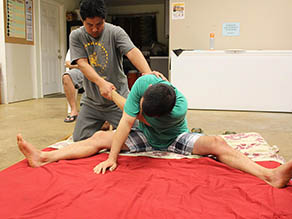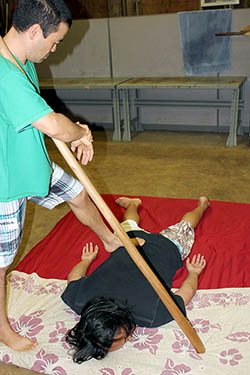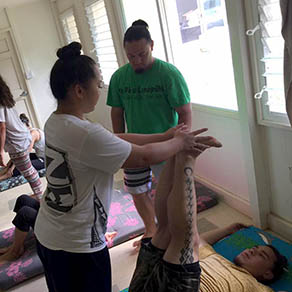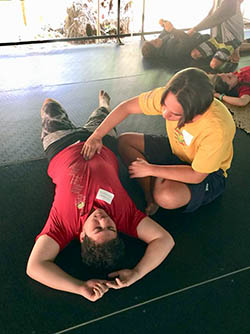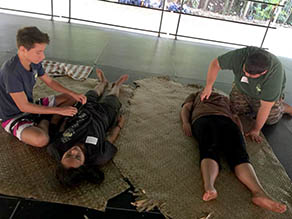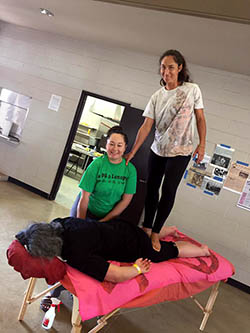 |
 |
 |
 |
||||||
|
|
|
|
|
|
|
|
|
|
 |
“With lomilomi, I like the ‘ōlelo no‘eau, ‘‘A‘ohe pau ka ‘ike i ka hālau ho‘okahi,’” Kamaka begins, “‘Not all knowledge is taught in the same school.’ Everybody has their own explanation, everyone got their own style of lomilomi, everyone got taught differently. I’ve been blessed to have learned from different people. And for a lot of different kumu, lomilomi is that balance or that sense of pono with the body, the mind and the spirit. “It’s a collaborative effort in realigning the body in some sense, and figuring out again what people need and addressing that through lomilomi. It could be through a massage, could be through an adjustment, it could be through a lot of different aspects. So in a sense lomilomi is a balancing of the body, the mind and the spirit. It is just not a physical massage. It’s also incorporating those pule that are important, or the permission. So it’s not just one physical rub down.” “The first and foremost is to address illness before you can even see it,” says Keola Chan. “If you’re looking at somebody healthy, the question is, how do we maintain health? So there is lomilomi to maintain health, and that’s the ideal; that’s the proactive, preventative measures our kūpuna were very conscious of. When you look at their lifestyle and healing practices, more of the work was put into the proactive parts of it, not in the reactive. Not like, ‘Kehi is sick now. Let’s try and lomilomi him.’ “So on the early side, when you’re looking at lomilomi to maintain health, it’s just being preventative, really. It’s just maintaining his health and well-being; keeping the system flowing, keeping the rivers clear, keep making sure that the waters are healthy to feed what is before us. When those things become stagnant, that’s da kine water going trickle in. That’s the kind of system that’s going to develop in you, so you want to keep it nice, and healthy, and working good. Lomilomi really looks at all those pieces.” “It’s easy when you try to maintain something. Then the approach and the work you do is very different compared to somebody that’s coming in with a certain injury, pain, carrying certain kaumaha or heaviness. That’s a totally different type of approach in work. “You prepare for both always. And the preparation of yourself and the work you’re about to do is very important in the whole scheme of it as well. What you’re doing is really trying to restore mana. You are trying to get the individual back to a state of pono or balance again. That’s why it’s important to be able to assess, because you got to know where the imbalance is. If it’s here, or here in the physical realm, is it spiritual, emotional? Are they off their rockers right now, from maybe finding out he lost his job, or girlfriend cheated on him? What is going on? “Or is it mentally, where there’s so much in their mind they cannot get out? Too much thinking that they cannot connect to what is happening around them? It’s identifying those things while you working with individuals. The task is really to bring a restored sense of balance to them, and you have to identify what those things are.” "I’ve heard a bunch of different thoughts about mana,” Kamaka says. “Everyone has their own interpretations of these things, that’s why a lot of the language too is contextual: how you speak on different aspects is depending on the different situations that are at point. Some people talk about someone’s mana level being low, if someone is low in energy. I sometimes see someone has that kaumaha or sadness, you look at this person and see them with shoulders forward, head down. That sadness, people might say, ‘Oh his mana level is a little low. He needs to get restored a little bit.’ In some sense it’s a continual learning process, observing people and having a concept of mana as relates to healing.” “The aim of lomilomi is restoration—maintaining that sense of pono in that person. Figuring out where the imbalance is within that person and trying to create a closer balance of pono with that person. If they feel better than when they first came to us, it’s always a plus, but sometimes people need to go through that suffering and that pain too to gain their own understanding. That is why it is important for people’s journey. Sometimes people got to be sick so that they can learn what it feels to be sick, so that they can help others. “I just had a conversation with one of our kupuna, Kaipo Kaneakua, who was talking about having all these experiences, going through these back pains , having certain illnesses and sicknesses so that you understand how it feels. You then understand how to overcome these issues. Without these things. you don’t know how they feel. If someone comes to you with back pain but you never had back pain before, you don’t know what it feels like. If someone had ‘ōpū huli and their stomach was all messed up, they couldn’t lift up, they’re lying crunched down, if you went through it and you know how it feels, then you have a greater understanding, more sympathy." Keola talks about fear of touching in modern medicine “My mom was one of those,” Alice says. “She would do the stomach: if you have stomach problem there. She will do that and a lot of old people did that. They can take care their children, grandchildren by doing all that. The old people did. That lomilomi was for the stomach, the back or whatever they had to do. The Portuguese call one kind of stomach ache the bush, where your stomach gets all like it’s just pushed one way and they have a certain way to rub it. Cry all day but when that’s done, it’s over.” “Sometimes illness is a good reminder to slow down,” Kamaka adds, “to be better observers, to take care of ourselves more. I think a lot of times we are so busy just going, going, going, doing for others, doing all kinds of crazy stuff. Sometimes we need a good sickness to make us slow down a little bit. Sometimes it is good to be sick, in some sense. It teaches us to slow down, teaches us what’s really important in life. "You notice sometimes when someone is diagnosed with some big disease like cancer or whatnot, it brings families together and brings some issues out in the open that needed to be uncovered. So in some sense, it could be important when we are sick. We get a better understanding of ourselves, of the importance of relationships with our families, with the community, with our ‘āina, with our akua. “I teach a four-year course,” Keola points out. “I teach them and I tell them, ‘Hey, because you’re not giving no degree, no paperwork, no special certificate. You going get ‘ike. You going get Hawaiian knowledge, Hawaiian understanding philosophically, historically, practical skillsets, knowledge. You got to put all of those things together to advance, and hopefully at some point you get wisdom in this practice.’ People come to my class, they think, ‘Oh, we’re going to learn lomi from Keola tomorrow!’ Hah, that’s what you think. The first year, they don’t get to touch each other—actually physically work on each other—for like eight months. I got to know that you know what you’re doing before you can even touch somebody, so it’s really about healing the healer first. “But when you’re touching that next person, now you’re creating space for somebody to walk in into, and you got to be able to take on what they bring in, because they may leave stuff. If you’re not prepared for it, they’re going to leave a whole bunch of rubbish for you to clean up. It’s preparing the person to be able to do multiple things in this practice of healing that is just not a physical thing. Like, I’m going to put the shoulder back into its socket. Okay, that’s the easy part. And that’s what a lot of people are fascinated by. “Lomilomi is not a fragmented practice. It’s not like it’s chiropractic work here, muscular manipulation is there, nerve and mental health; it’s all one. They’re all connected and they all make up the individual, and you cannot separate and say, ‘Okay, I’m only going to do your adjustments, and then somebody else will come and do these other things.’ You got to take this all. “We look at the person’s entire piece. If you’re going to realign your structural system, then I got to address the muscular system that maybe for the past six months that because your shoulder was slightly out of place, you have muscles that adjusted and not used to being in that place. They got used to being out of placement. “So, I got to realign you, and then I got to work on the muscle to understand, ‘No, this is where you belong.’ I got to work with the nerves and circulatory system to say, ‘This is how you need to flow. For a long time, your river has been made this way, off to the left. I got to bring you back on track.’ But those things are the basics. Students really appreciate the class towards the end because they understand, it takes them that long for get ‘Wow, the stuff that I was getting frustrated, I came in, I thought we were going to learn all these physical manipulation of the body, and you held it out for us. You made us learn all these other things first,’ so that by the time they got to this, they were like, ‘Oh, so easy this part.’ They’re picking up real quick, but the real meat of it is in this unseen part of healing, of the unseen. “I don’t have like 50 minute or one-hour massage. I don’t have that. I don’t book like 20 people in one day. I’d book one or two maybe, three at the most because I want time with you. And after I work on you, I want to sleep after. I don’t want to be like, ‘Okay, we’re done. You got to leave.’ I may want to talk with you for an hour. Or you may want to talk for an hour and then get a lomi after that, but I don’t want you to feel like there’s somebody waiting, you got to rush out of here. “Healing, there’s not a time frame for that, and my clients all know that. If you do come, at the 2-hour mark and I’m still in session, don’t you come knocking on my door because when you come in, you may take 3 to 4 hours. My clients understand that. Healing takes time sometimes. Sometimes early; they get off half hour. You put them back in place, boom, they’re ready to go, but that’s on them. You got to create the space that is comfortable, because that’s my responsibility, is that not just myself and the work but the space. “And if you like quit my class, I encourage you to leave because that you’re not ready for taking on the responsibility. You just see it as a move, a fancy move, a technique: squeeze squeeze, push push. If that’s what you like to learn, go get it from somebody else. Hawaiian healing is deep, it can be. I put you on the floor, we’re going to twist you, stretch you, realign you, all those good things. Those are the easy things to me. It’s really understanding the work in them. The whole totality of what you’re doing. You got to understand all the pieces to the pie. Look at the puzzle as a whole and not just the one piece you hold in your hand that you want so badly.”
|  |
|||||||
 |
But both internal and external treatments include consideration of the whole person, what they are going through in their lives and in their interpersonal relationships. Hawaiian healing always involves the spiritual component.
|
 |
||
 |
|
 |
||

|
 |
||||
|
||||
Copyright 2019 Pacific Worlds & Associates • Usage Policy • Webmaster |
||||

